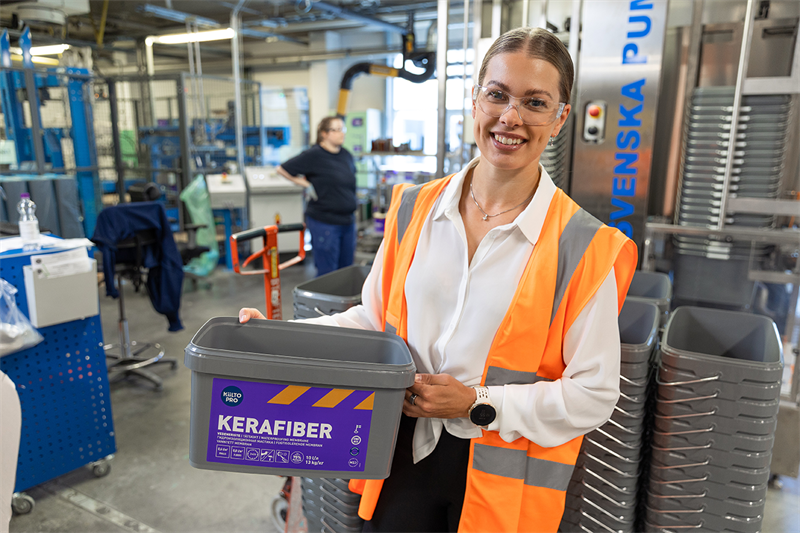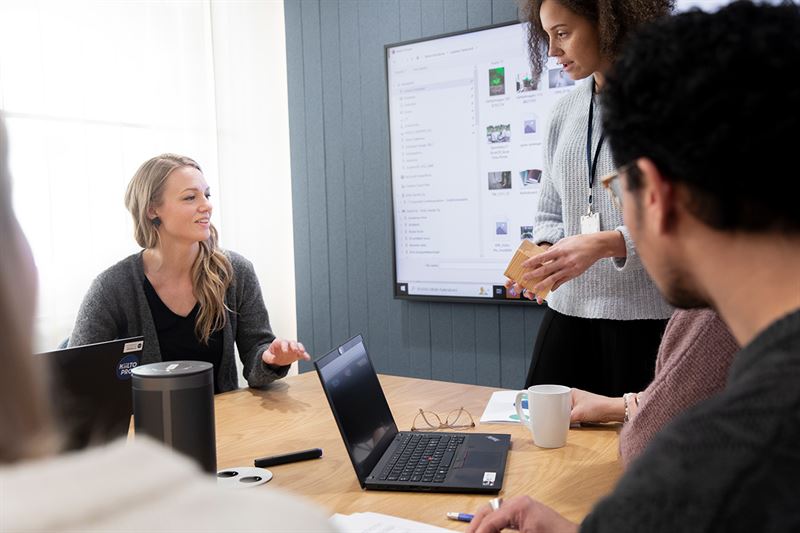Biodiversity, water use and collaboration with customers are now an even more integral part of Kiilto’s Promise to the Environment
Environmental awareness and understanding of responsibility as a whole are increasing by leaps and bounds, which is good, as it also creates pressure for companies to keep up with the times. As an operator in the chemical industry, Kiilto approaches the matter particularly from an environmental point of view, with the aid of its Promise to the Environment. Ever since setting the goals, it has been clear that they must genuinely drive a change for the better.
The promise has been kept. This is evident in the goals met and the lessons learnt, due to which it was time to update the Promise.
“It seems that we need to make an update every two years. On the one hand, because in two years, we’ve taken clear, concrete steps and already met some of the goals, and, on the other hand, because understanding of sustainability and, consequently, general standards have increased,” says Kiilto’s Research, Development and Innovation Director Oili Kallatsa.
Kallatsa sees both developments as equally important.
“Achieving goals gives a sense of achievement and keeps people motivated, which is extremely important, whereas public debate and increasingly stringent requirements drive sustainability,” sums up Kallatsa.
New goals to replace those that have been met
Kiilto has deliberately set the goals concerning its Promise to the Environment for the near future. A timeline of a few years effectively guides activities and thinking towards concrete changes. Kiilto’s long-term goal is to become an environmental leader in the industry.
Since the last update, for example the following goals were met:
-
The goal related to packaging – 70% of our packaging will be reusable or made of recycled of renewable materials by 2025 – was achieved in Finland in Kiilto’s Construction as well as Industrial Adhesives and Fireproofing business areas.
-
The goal to double the amount of recycled and renewable raw materials used at our chemical plants was achieved in Finland in the Professional Hygiene business area.
-
The goal to reduce the amount of material used by our customers – 50,000 kg a year – was achieved many times over. The most significant single measure taken to achieve the goal was the ProCIP optimisation and monitoring solution, which helped us save over one million litres of water. In addition, other optimisations helped us save almost 700 000 litres. Smaller savings in packaging waste, for example, were achieved with the SafePoint+ dispensers, tanker deliveries of floor-levelling compounds and bulk deliveries.
-
At the end of 2021, the consumption of purchased energy per tonne produced was reduced by about 18% (the goal to be met by 2025 was -20%).
-
The intensity (kg CO2/kg product) of direct CO2 emissions included in Scope 1 was reduced by about 32% during 2018–2022. This was made possible by the system in Lempäälä, enabling a hybrid system and two-way heat trade, which has significantly reduced our gas consumption.
Lessons learnt on our way towards environmental leadership
Kallatsa and Kiilto’s Environmental Manager Viivi Kettula point out that the efforts to keep the Promise are not always easy to make and that they do not always succeed. Environmental issues require a great deal of research. For instance, issues related to biodiversity are relatively new to companies. According to a report by WWF, only one in three companies has included a section on biodiversity loss in their sustainability strategy.
“To include biodiversity in the Promise, we conducted a materiality analysis on the different categories of biodiversity. We used the same tools that were used in the biodiversity survey, in which we also participated, carried out in the chemical industry last spring. The analysis showed that the categories most relevant to our operations are greenhouse gas (GHG) emissions and land use. The survey did, however, bring to light the difficulty of measurement, as GHG emissions were the only category for which clear indicators exist. Also in this regard, the area in which we have the best opportunity to make a difference is our supply chain,” sums up Kettula.

Since there is no common approach to many of the environmental and responsibility issues yet, companies and organisations have to create their own ways of handling the matters.
“We need to act now. Companies must be able to react quickly based on the best information available. It takes courage to take the first step, and the plans must be adaptable as we gain more knowledge,” says Kettula.
“Environmental work is closely connected with understanding the impact of the company’s value chain. Many of the related tools are only just being developed, and there is an enormous amount of work to be done. That slows down the progress. Companies need each other and shared ecosystems to address challenges and achieve goals,” continues Kettula.
According to Kallatsa, the dissemination of information in an international organisation also poses its own challenges.
“Different countries and functions may vary greatly in their level of environmental awareness and understanding. Even if there is an environmentally-oriented corporate culture in place, measures taken on the large scale may sometimes seem irrelevant to the daily work. That’s why it’s important to pay attention to the impact of the actions on different levels,” points out Kallatsa.
“Our Promise to the Environment requires continuous internal training. Increased understanding also facilitates the collection and measurement of data and generates new ideas.”

Four major changes
In spring 2022, Kiilto committed to the Science Based Targets (SBT) initiative. One of the updates that needed to be made in Our Promise to the Environment was aligning the energy and climate goals with the SBT initiative. At the same time, we changed the name of the area to Energy and Climate (previously Green Energy).
Kiilto’s Promise to the Environment did not previously include separate goals for biodiversity. This was also something that Kiilto wanted to change.
“Despite the fact that biodiversity is still a relatively new area with lots to explore, the most important thing is to take the first step. The matter is not simple, as there may sometimes be a conflict between emission goals and biodiversity objectives. We want to play an active role in addressing biodiversity issues, but in a way that also takes account of climate matters,” says Kettula.
After updating the Promise, Kiilto will invest in both local emission offset projects and biodiversity conservation and collaborate with its partners to implement annual environmental projects that aim to maintain biodiversity.
The third major change is the addition of a water-use goal in Kiilto’s Promise to the Environment.
“Before this, water use had not been taken into account for our own operations, although we had been doing that via our customers in relation to our goal of reducing their material use,” says Kettula.
“Our current goal is to reduce process water consumption by 20% per tonne produced. We aim to make the reduction by 2028 from the 2021 level.”
According to Kettula, the initiative to set a water-use goal was made by Kiilto’s customers. Various Kiilto working groups had discussed the matter over the years, but the fact that the customers considered the goal so important made it clear that a water-use goal should be set right away.
In addition to the customers, Kiilto wanted to involve stakeholders even more actively in the Promise to the Environment.
“It’s important to us that Our Promise to the Environment has an impact beyond our own operations. Now our stakeholders are a more visible part of our biodiversity goals, for example. What is more, we also changed the name of the Green Services area to Partnership, which better reflects our desire to succeed together with our customers and stakeholders. We want to help our customers reduce their environmental footprint, and we’ll report on the results annually,” says Kallatsa.
“Another new goal is to make the carbon footprint calculations of Kiilto’s solutions available starting from 2025,” adds Kettula.
“This will also help our customers manage their own environmental activities.”
Based on a strong environment-oriented culture
Kiilto made its Promise to the Environment in 2018. The goals were updated in 2020, at which point the goals achieved were replaced with new ones and the measurement methods were specified.
“Already when first working on the Promise, we realised that it was not a project, but a Kiilto way of thinking. We identified eco-friendliness as an integral part of Kiilto’s culture, and environmental leadership became the fourth cornerstone of Kiilto’s culture,” says Kallatsa.
“This time, updating the Promise involved a more diverse group of Kiiltonians than ever before. There were representatives from all the countries in which Kiilto operates,” says Kallatsa.

Our Promise to the Environment:
Energy and climate:
All our company operations will be carbon neutral by 2028 and we reduce our scope 3 emissions
By improving our energy and material efficiency, we are playing our part in combating climate change and promoting sustainability. In production, we invest in environmentally friendly technology, as well as clean and energy-saving production processes. We have set a goal to be a carbon neutral company by 2028.
In order to get there, we have smaller targets to hit along the way.
- By 2028, we will only use carbon neutral energy
- By 2031, we will decrease our indirect GHG emissions 21% from the level of 2021.
(SBT requirement for scope 3 emissions, 10 years and 21%) - By 2028, we will reduce our purchased energy consumption per produced tonne 10% from the level of 2021
- We invest in local carbon off-set initiatives and biodiversity preservation.
Packaging and logistics:
We reduce the use of fossil and virgin packaging material every year
When developing products, we continuously seek raw materials and forms of packaging that are kinder to the environment. By growing sales of our environmentally and safety-classified products, we are improving occupational and customer safety in our own working environment and customers’ premises.
- 70% of our packaging material is reused, renewable or recycled by 2025.
- By 2028, we will decrease the fossil energy consumption of our delivery logistics to customers 20% from the level of 2021
- We will decrease the material amount used in our packaging per produced tonne annually
- We will pilot refillable packaging solutions also for smaller packaging (<200L) by 2024
Partnership:
We enable our customers to minimise their environmental footprint
In addition to optimizing our own operations, we provide our customers with more environmentally friendly products and services that help them to have more sustainable processes, working methods and end products. Increasing understanding of the environmental aspects is crucial in continuous improvement and that is why training plays a very important role in our green services.
- We help our customers to reduce their environmental footprint (carbon footprint, water- or material usage) and report annual reductions
- All of our trainings and discussions with stakeholders include an environmental aspect. We train around 25 000 people annually
- We will make environmental initiatives annually to preserve biodiversity together with our main partners
- We will provide carbon footprint data for our solutions from 2025 onwards.
Materials:
We use less fossil and virgin raw material and reduce waste every year
We promote the circular economy and use bio-based raw materials to decrease our use of non-renewable natural resources, while reducing our carbon footprint by lowering waste amounts and using our production side-streams. We also investigate opportunities for using recycled raw materials that are by-products of other industries.
- By 2025, we will double the use of recycled and renewable raw materials in our chemical factories compared to the level of 2018
- We will halve the waste amount by 2025 compared to the level in of 2018
- By 2028, we will decrease the carbon footprint of our raw material portfolio 15% from the level of 2021
- By 2028, we will decrease the water consumption of our processes 20% from the level of 2021 per produced tonne
Tags:





